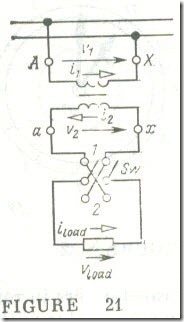Phase Displacement (Reference Phasor) Groups
Under normal operating conditions, the primary and secondary voltages v1 and v2 are practically in phase with the respective currents, il and i2, for the positive directions chosen in Fig.21. For the chosen positive directions of the load current iload and load voltage vload it follows that iload = i2 and vload = v2 if the switch Sw is in position 1, or iload = – i2 and
vload = – v2 if the switch is in position 2. In the former case the load current and voltage are in phase with the secondary current and voltage of the transformer; in the latter case they are in anti-phase. These phase relations are very important when transformers are to be run in parallel, or when using instrument transformers, etc.
In terms of the phase difference between the secondary and primary voltages, transformers are classed into phase displacement (or reference phasor) groups. In assigning a phase displacement group to a transformer, its voltage on the H.V. side is assumed to be primary, and that on the L.V. side, secondary.
The phase difference used as a basis for this classification is that between the line high and low voltages. For two transformers falling in the same reference group this phase displacement is the same, and the two are assigned the same reference number.
A convention adopted internationally is to indicate phase displacement as a clock figure representing the hour read by a clock when the minute hand takes the place of the primary line voltage phasor in a complex plane and is set at 12 o’clock, and the hour hand represents the secondary line voltage phasor. Since an angle of 30° is exactly the central angle between adjacent hour markings on a clock dial, it is taken as the unit of phase displacement. The phase displacoment is counted from the minute to the hour hand in the same direction as they rotate. The "time" thus read is the reference number assigned.
In a single-phase transformer, the secondary voltage phasor can make with the primary voltage phasor an angle of about 0° or of about 180°. In the former case, the respective clock-hour figure is 12 (or 0), and this phase displacement group is assigned reference number 0 . In the latter case, the respective clock-hour figure is 6, and this’ phase displacement group is assigned reference number 6 . In this case the primary and secondary windings are wound in opposite directions with respect to that of the magnetic flux. In the USSR, single-phase transformers come only in reference group 0 .
With three-phase transformers, all the 12 clock-hour groups are possible in principle. For standardization purposes, however, only "two have been chosen. They are (at least in the Soviet Union) reference group 11 and reference group 0 . Transformers in reference group 11 are used with their windings connected star to delta (Y/ Δ-11) and star (with the neutral point brought out) to delta (Yn/ Δ-11).
Transformers in reference group 0 have their windings connected only star to star with the neutral point brought out (Y/Yn-0). The numerator always refers to the H.V. winding.
The Y/Y n-0 connection is used for transformers in which the .high voltage is up to 35 kV and the low voltage is 230 V, the power rating being up to 560 kVA, or with the same high voltage, a low Voltage of 400 V, and a power rating up to 1.8 MVA. Both forms of connection in reference group 11 are used for bigger transformers and at higher voltages.
As an example, Fig.22 shows a star-to-delta connection in which the low (that is, secondary) voltage phasor V̇ab makes an angle of 3300 with the high (that is, primary) voltage phasor V̇AB .
This phase displacement corresponds to a clock-hour figure of 11, so this connection falls in reference phasor group 11 .


